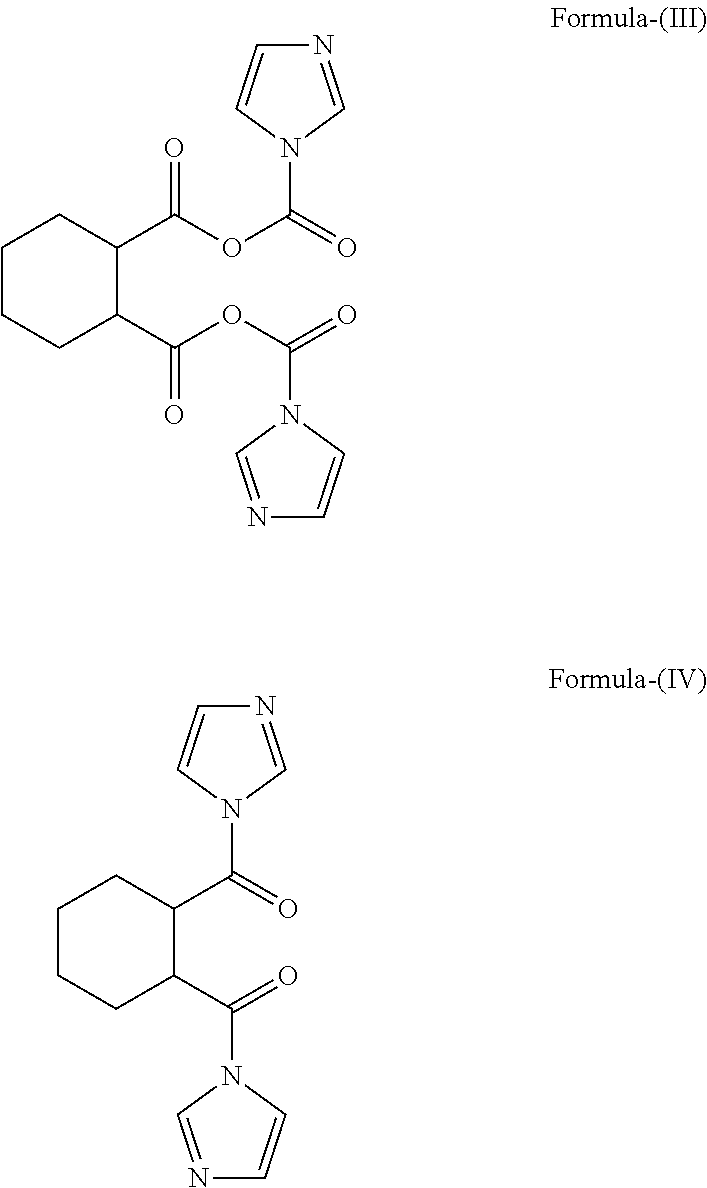An improved process for the preparation of lurasidone hydrochloride
a technology of lurasidone hydrochloride and improved process, which is applied in the field of improved process for the preparation of lurasidone hydrochloride, can solve the problems of increasing production cost, unable to carry out resolution, and inability to use column chromatography for purification on commercial scal
- Summary
- Abstract
- Description
- Claims
- Application Information
AI Technical Summary
Benefits of technology
Problems solved by technology
Method used
Image
Examples
example-1
Synthesis of trans(R,R)-1,2-cyclohexane dicarboxylic acid
[0114]A round bottom flask was charged with methanol (500 mL), IPA (500 mL) and trans (racemic)-1,2-cyclohexane dicarboxylic acid (100 g). In this reaction mass (R)-1-phenylethyl amine (74 mL) was added over a period of 30 minutes and stirred for 2-3 hrs at 30-40° C. The solid obtained was filtered, washed with methanol and IPA solution (50+50 mL) and dried under reduced pressure to obtain crude salt of trans(R,R)-1,2-cyclohexane dicarboxylic acid. The obtained salt was stirred in a solution of methanol (500 mL) and IPA (500 mL) at 65-70° C. for 2-3 hours, cooled to room temperature and filtered. The solid was washed with methanol and IPA solution (50+50 mL) and dried under reduced pressure. The solid thus obtained was dissolved in about 2N hydrochloric acid and extracted two times with ethyl acetate (1000 mL+200 mL). Organic layers were combined and washed with brine solution (100 mL). Ethyl acetate was distilled off under va...
example-2
Synthesis of ((R,R)-cyclohexane-1,2-diyl)bis((1H-imidazol-1-yl)methanone)
[0115]To a solution of trans(R,R)-1,2-cyclohexane dicarboxylic acid (25.0 g) in THF (250 mL), carbonyl diimidazole (60 g) is added and stirred for one hour at 25-30° C. To the said solution of (R,R)2-(((1H-imidazole-1carbonyl)oxy)carbonyl)cyclohexanecarboxylic acetic anhydridelH-imidazole (25.0 g) in THF (250 mL) is stirred for one hour at 45-50° C. The compound obtained is isolated and is characterized by mass and NMR.
[0116][m / z=272.75; 1H-NMR: 8.24 (s, 2H), 7.72 (d, 2H); 7.50 (d, 2H), 3.5 (m, 2H), 2.26-1.50 (m, 8H)]
example-3
Synthesis of trans(R,R)-1,2-bis(hydroxymethyl)cyclohexane
[0117]To a solution of ((R,R)-cyclohexane-1,2-diyl)bis((1H-imidazol-1-yl)methanone) (25 g) in THF (250 mL), sodium borohydride (22.0 g) followed by water (44.0 mL) are added and stirred for one hour. To this reaction mass, 10% solution of acetic acid (500 mL) and dichloromethane (500 mL) are added, stirred and layers separated. The organic layer is washed with 10% sodium bicarbonate solution followed by water. The dichloromethane is distilled off from organic layer under vacuum to give an oily mass. To the oily mass dichloromethane (100 mL), water (100 mL) and 12.5 mL conc. hydrochloric acid (35%) are added, stirred and layers obtained are separated. The dichloromethane is distilled off completely from organic layer at 40° C. to obtain oily mass (15.5 g).
PUM
 Login to View More
Login to View More Abstract
Description
Claims
Application Information
 Login to View More
Login to View More - R&D
- Intellectual Property
- Life Sciences
- Materials
- Tech Scout
- Unparalleled Data Quality
- Higher Quality Content
- 60% Fewer Hallucinations
Browse by: Latest US Patents, China's latest patents, Technical Efficacy Thesaurus, Application Domain, Technology Topic, Popular Technical Reports.
© 2025 PatSnap. All rights reserved.Legal|Privacy policy|Modern Slavery Act Transparency Statement|Sitemap|About US| Contact US: help@patsnap.com



